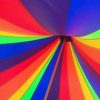Understanding the Colorful Magnetic Muon
As we discussed in a previous post, “Magnets & Photography,” art and magnets don’t often cross paths. But when they do, they make for some stunning pieces. Artists Nathalie Kalbach and Urii Guchenia at the Chicagoland Nathalie Studio have created a stained glass representation of the magnetic field inside the Muon g-2 (“gee minus two”) experiment at Fermilab.
The Muon g-2 is the brainchild of the folks who played a major role in the discovery and understanding of the Higgs Boson particle This was a particle physics experiment that could provide evidence of the existence of entirely new particles. The experiment studies the interaction of muons with a strong magnetic field in what they refer to as an “empty” space. The main goal of the experiment overall is to test the validity of the Standard Model’s predictions. The Standard Model is a theory describing three of the four known fundamental interactions of nature, those being gravitational, electromagnetic, strong, and weak. How this experiment turns out could determine if the Standard Model needs to be adjusted.
What the Heck is a Muon?
A muon is an unstable subatomic particle and acts as a spinning magnet. In the experiment, an aligned beam of muons are directed into a ring with a specific magnetic field. Scientists then measure the precession, or wobbling, of the muons to determine the magnitude of the precession in relation to the difference between g and 2, or g-2.
In order to complete the experiment, the central ring of magnets must be kept uniform and the ring is checked regularly to ensure this. Slices of this ring of magnets were taken and converted into a 2D map. This map was then converted to the beautiful stained glass creation concocted by Kalbach and Guchenia at the Chicagoland Nathalie Studio.
Magnets Meet Art
Looking at their artwork, you can see exactly how uniform the magnetic field is with the red and blue portions indicating the greatest non-uniformities. Although, this colorful map is already outdated! Ran Hong, the mastermind behind the artwork and the owner of the piece says “We've since corrected for the non-uniformities at that level and are now getting it even more uniform."
Hong enjoys this intersection of art and science and says it helps him to better understand complex physics concepts explaining, "When I or the public see a visualization, it gets rid of the math, and we can think more about the physics behind it and why it is the way it is.”
We hope to see more mergers of art and science—especially when magnets are involved. Looking to stay up to date on the latest magnetic news? Be sure to follow along with our blog and check out our catalog for the newest products.

